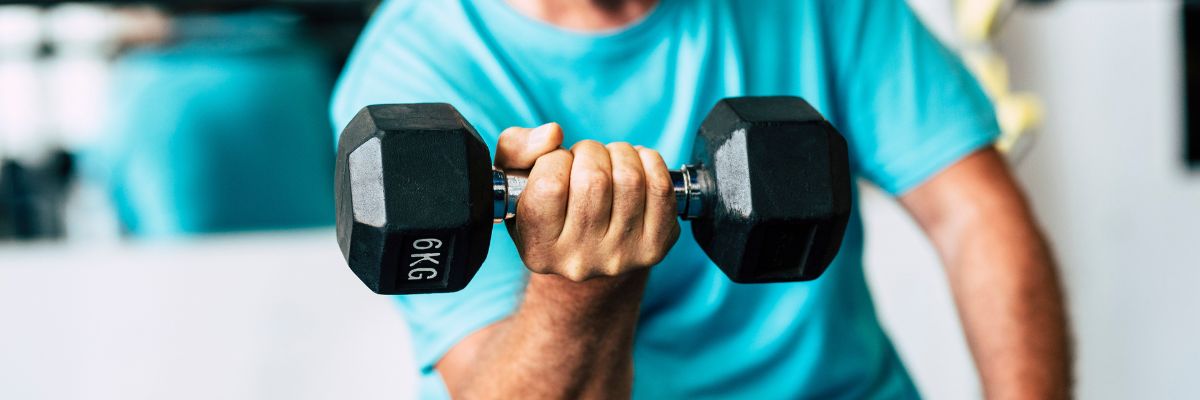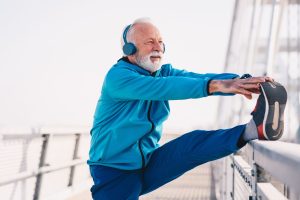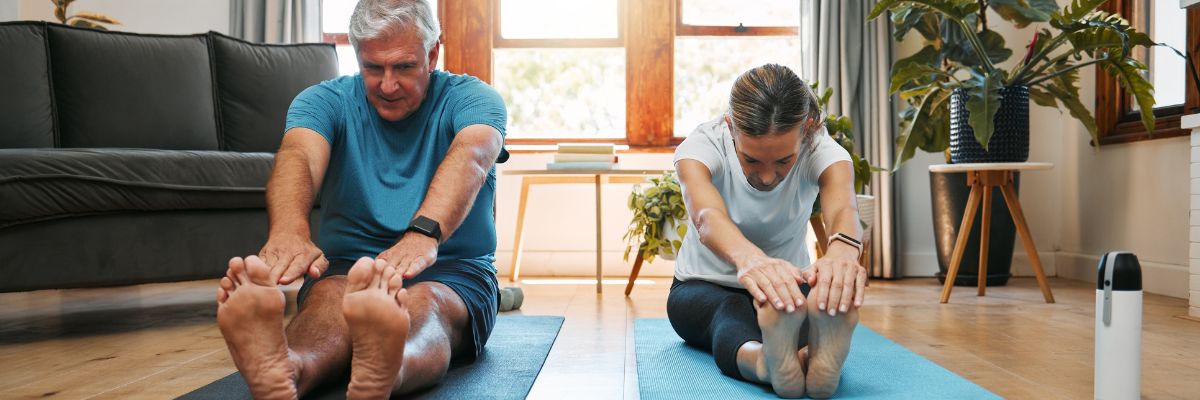
Recovery timeline after surgery
Recovery timeline after surgery, that is after radical prostate surgery, varies from person to person depending on how their body heals naturally and the severity of the disease before surgery.

Cancer - Prostate

Cancer - Prostate

For Prostate Cancer Awareness Month, we are taking the opportunity to encourage you to make small changes to enhance your overall well-being.
As maintaining a healthy and vibrant lifestyle is crucial for your quality of life (regardless of your prostate cancer diagnosis), we present below five health-beneficial behaviors. We invite you to consider which one you find most achievable to adopt in your daily routine over the next 21 days, at a time that suits you perfectly. Each of these behaviors is accompanied by additional information and practical tips to guide you in your journey and facilitate your choice.
Physical activity is essential throughout life, especially before, during, and after prostate cancer treatment.
It improves the management of this condition and plays a crucial role in preventing serious chronic diseases, such as cardiovascular diseases and diabetes. Furthermore, it promotes a healthy weight, enhances sleep quality, and strengthens the immune system, thereby increasing the body’s resilience against health challenges. Every step you take and every movement you choose gives you energy and brings you closer to overall well-being.
If you’re considering starting an exercise program, it’s advisable to consult a healthcare professional, especially if you have pre-existing health issues. Don’t hesitate to seek the assistance of a kinesiologist or physiotherapist to support you on your journey. For most individuals, engaging in physical activity before, during, and after cancer treatment is generally safe. If you’re unsure, consult your medical team for guidance.

Modifiable Behavior : Prolonged sitting
To reduce sedentary behavior and avoid prolonged sitting, incorporate simple physical activities throughout the day. Take short active breaks every hour. Get creative in finding ways to move more in your daily routine. Of course, it might sound easier said than done, but let’s look at some basic principles below to guide you.
Excessive sedentary behavior, characterized by prolonged periods of sitting, poses numerous health risks, including back and shoulder pain, poor blood circulation, reduced muscle activity, and a slowed metabolism. Moreover, it’s linked to an increased risk of cardiovascular diseases, type 2 diabetes, musculoskeletal disorders, and certain cancers. Additionally, prolonged sitting can worsen urinary symptoms associated with prostate diseases.
Sedentary behavior is a wakeful state characterized by very low energy expenditure. Sedentary behaviors can occur while sitting, lying down, or standing without movement. For example:
Other benefits of avoiding prolonged sitting:
Don’t know where to start? Here are some practical tips:

Recovery timeline after surgery, that is after radical prostate surgery, varies from person to person depending on how their body heals naturally and the severity of the disease before surgery.

Whether you are doing it for your physical or psychological well-being, or for staying in shape, fighting fatigue or sleeping better, or accelerating your recovery, physical activity during or after
Click on the links below to access more information that will help you fulfill your commitment:

Modifiable Behavior : Neglecting to incorporate exercise into your routine
According to all studies, it is recommended to include 30 minutes of moderate-intensity physical exercise, totaling 150 minutes per week, along with strength, flexibility, and balance exercises. By incorporating exercise into your daily routine, you strengthen your muscles, bones, and cardiovascular system, while also promoting the release of endorphins that improve your mood and reduce stress. Of course, it might sound easier said than done, but let’s look at some basic principles below to guide you.
Because it’s essential to find ways to maintain our health, mobility, and independence. Moving brings benefits. The more active you are, the more you’ll feel the health benefits in terms of your mood, focus, confidence, and resilience, as well as improved sleep, regardless of your starting level. Moreover, physical activity can help you feel better when receiving or recovering from prostate cancer treatment.
Did you know that physical activity isn’t limited to sports? It encompasses all body movements generated by muscles, resulting in energy expenditure greater than that during rest. So, being active doesn’t necessarily mean engaging in intense sports or going to the gym.
For instance, everyday physical activities include:
It’s crucial to choose activities that you enjoy, as that’s the best way to sustain them. You can break down the recommended 30 minutes into consecutive 10-minute segments throughout the day. Even short 5-minute sessions multiple times a day are beneficial for your body and will help you achieve your physical activity goals.
To maximize health benefits, it’s important to add some intensity to physical efforts. In fact, based on the effects it has on the body, physical activity can be classified as light, moderate, or vigorous intensity. Therefore, it’s recommended to prioritize moderate-intensity physical activities that require increased effort for breathing and elevate heart rate.
Here are some examples:
Other benefits of increasing your daily physical activity to 30 minutes:
There are numerous advantages to moving each day, particularly for men battling prostate cancer due to the side effects, such as those related to hormone therapy.
Physical activity improves your:
Simultaneously, it reduces your:
Not sure where to start?

For a healthy prostate, prevention is the best remedy, and exercise, such as the benefits of walking, can be one of your great allies. Essential in the role of your

In Quebec, we love sports and activities to keep fit after 50 years. We “eat” hockey, “wait” for the return of the Nordiques, hopefully the Expos, support the Alouettes and

Modifiable Behavior: Neglecting muscle work
Incorporating two strength training sessions per week promotes muscle growth, enhances posture and stability, strengthens bones, and helps prevent injuries and fractures. It also contributes to boosting metabolism, thereby supporting weight loss and weight management. Of course, while this might seem straightforward, let’s delve into some basic concepts below to guide you.
Neglecting to engage in strength training exercises can lead to loss of muscle strength, joint and bone stability, and a less active metabolism. This compromises injury prevention, fracture prevention, prevention of muscle mass loss related to prostate cancer treatments like hormone therapy, and weight management, thereby limiting long-term health benefits.
Sarcopenia is a medical term that refers to the progressive loss of muscle mass and strength that typically occurs with aging.
The production of muscle proteins decreases over the years, leading to a gradual loss of muscle mass and strength. Muscle fibers may contract less efficiently, resulting in weakness and decreased muscle function.
This decline in muscle mass can lead to poor posture, reduced mobility, and increased vulnerability to injuries. Sarcopenia can affect the ability to perform daily activities such as climbing stairs, lifting heavy objects, or even getting up from a chair.
Adopting a regular strength training exercise routine can slow down sarcopenia by stimulating muscle growth and maintenance, strengthening bones, and improving their strength and function.
Other benefits of engaging in strength training exercises twice a week:
Strength training exercises have a significant impact on mental health, positively contributing to several aspects of emotional well-being.
Not sure where to start? Here are some examples of simple exercises that can be integrated into a weekly routine to help strengthen muscles, improve strength and mobility, and contribute to an active and healthy lifestyle. Stretching helps maintain flexibility and prevent muscle stiffness.
You can also do strength training exercises with bands, dumbbells (weights, water bottles, canned goods), alone, in a group, or online by watching pre-recorded videos.

Physiotherapy in perineal and pelvic rehabilitation is often recommended by urologists, especially following radical prostate surgery. To familiarize yourself, here is your pelvic rehabilitation in 5 points. But before tackling

Treatment for osteoporosis aims to increase bone mass and reduce the risk of fractures. How to take care of your bones is an article co-authored by two experts – a dietitian and
Click on the links below to access more information that will help you fulfill your commitment:

Modifiable behavior: Not increasing activity intensity
Increasing the demand of your activity in terms of intensity is important because staying at a low or constant intensity level can lead to a plateau in health benefits. By gradually increasing the intensity of your physical activities, you challenge your body and muscles, leading to better results, improved physical fitness, and an increased metabolism. Of course, this may sound simple to say, but let’s explore some basic principles below to guide you.
Ignoring the importance of increasing activity intensity can lead to a plateau in physical progress, limiting gains in strength and endurance. This could also decrease long-term motivation and hinder the achievement of desired fitness goals. Neglecting to diversify the intensity of exercise may result in missing out on the potential benefits of ongoing improvement in physical activity.
Did you know that physical activity is characterized by its intensity? Based on the effects it has on the body, physical activity can be classified into light, moderate, or vigorous intensity levels.
During light or low-intensity physical activity:
During moderate-intensity physical activity:
During vigorous-intensity physical activity:
Here are some examples of activities based on the desired intensity.
Light-Intensity Activities:
Simple activities that involve movement rather than staying seated or lying down.
Moderate-Intensity Activities:
Activities that increase heart rate and lead to slight breathlessness.
Vigorous-Intensity Activities:
Activities that significantly elevate heart rate and involve harder and faster breathing.
Making one’s activity more demanding can provide a sense of satisfaction and personal achievement, thereby strengthening the motivation to maintain an active and healthy lifestyle.
It can also increase self-confidence by making physical progress and overcoming challenges.
By engaging various muscle groups more intensely, it also promotes better muscle toning and bone strengthening.
The increased intensity can stimulate the heart and blood vessels, improving cardiovascular health. As they raise the demand for oxygen, they enhance the efficiency of oxygen delivery to cells.
Finally, pushing physical limits can also bolster mental strength, helping to better manage stress and daily challenges.
Not sure where to begin? To avoid unnecessary risk, the resumption of activities should be gradual, followed by an increase in intensity.
Here are some simple examples to increase the intensity of your physical activities:
If you’ve been treated for prostate cancer or are undergoing treatment:

What does it mean Preparing well: the key to taming side effects? This means taking charge of yourself to be able to tame and manage the side effects associated with

No serious scientific study has shown a link between sexual disorder in men, prostate disease and cycling. But the question Can cycling cause prostatitis? is tenacious and the information on the internet is
Click on the links below to access more information that will help you fulfill your commitment:

Modifiable behavior: Forgetting to diversify physical activities.
Incorporating flexibility and balance exercises into your routine is important, as it can improve your range of motion, reduce the risk of muscle and joint injuries, promote better posture and coordination, and help maintain optimal mobility as you age. Of course, this may sound simple to say, but let’s explore some basic concepts below to guide you.
This is important because it can prevent muscle and joint stiffness, reduce the risk of falls by enhancing stability, improve blood circulation to muscles and joints, and promote better movement quality in daily activities. Furthermore, it can help maintain a general sense of well-being and support optimal quality of life over time.
Balance is defined as the ability of a person to maintain a stable and upright posture, whether in a standing or sitting position, still or in motion. It is an unconscious process that results from a set of automatic movements.
Flexibility is defined by the range of motion around a joint. It improves muscle suppleness and also regulates the nervous system.
Regular training in flexibility and balance can also have positive effects on cognitive function. Studies suggest that these types of exercises can stimulate brain activity, enhance concentration, and improve coordination between the brain and the body. Thus, in addition to physical benefits, flexibility and balance training can contribute to maintaining a sharp and alert mind.
Certain sports are particularly effective for working on balance and flexibility: examples include aqua aerobics, yoga, and tai chi. In addition to balance, these activities help improve flexibility, another important quality in fall prevention. To achieve real improvement, consistency in your practice is key.
Incorporating flexibility and balance exercises into your routine is important. They enhance body awareness and help maintain better posture, which is essential for preventing falls, especially as you age. By strengthening the muscles around your joints and improving balance, you can increase your confidence during movements and minimize the risks of injuries resulting from accidental falls.
Are you over 50 and looking to assess your balance?
Barefoot, simply stand on one foot and press the free leg’s foot against the supporting leg, similar to how flamingos do. Ideally, the elevated foot should be at least knee height of the opposite leg. For added stability, you can place your hands on your hips.
Once in position, count the number of seconds you can maintain your balance before losing it.
Other benefits of incorporating flexibility and balance exercises twice a week:
Flexibility: You will be pleased to find that performing certain tasks, such as getting dressed, reaching for objects, or bending, will no longer be as uncomfortable and painful.
Balance: Balance-focused exercises promote a sense of control. Even better, they can alleviate your fear of falling.
Here are some examples of balance exercises you could integrate into your routine:
Here are some examples of flexibility and stretching exercises you could integrate into your routine:
Ensure you perform these stretches slowly and gently, without forcing. If you experience sharp or persistent pain, stop immediately and consult a healthcare professional.

Have you been diagnosed with prostate cancer? Your role as a patient is essential throughout your journey.
Consult the links below for more information about this commitment:
Written by PROCURE. 2023 © All rights reserved.

Prostate cancer
do not experience it alone.
Our healthcare professionals are here to answer all your questions and those of your loved ones. Contact us.
Contact Us
© 2023 PROCURE – All rights reserved
Registration number: 86394 4955 RR0001
Terms of use | Privacy policy